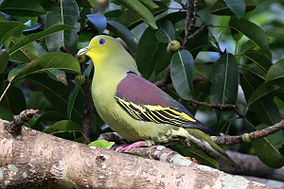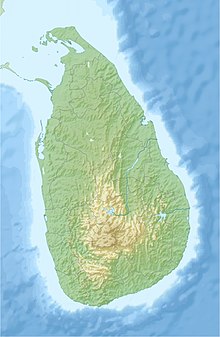Kaudulla National Park
| Kaudulla National Park | |
|---|---|
|
IUCN category II (national park)
|
|

A Sri Lanka Green Pigeon in Kaudulla National Park
|
|
| Kaudulla National Park | |
| Location | North Central province, Sri Lanka |
| Nearest city | Polonnaruwa |
| Coordinates | 8°09′40″N 80°54′18″E / 8.16111°N 80.90500°ECoordinates: 8°09′40″N 80°54′18″E / 8.16111°N 80.90500°E |
| Area | 6,900 ha |
| Established | April 01, 2002 |
| Visitors | 10,000 (in 2005) |
| Governing body | Department of Wildlife Conservation |
Kaudulla National Park is a national park on the island of Sri Lanka located 197 kilometres (122 mi) away from the largest city, Colombo. It was designated a national park on April 1, 2002 becoming the 15th such area on the island. In the 2004–2005 season more than 10,000 people visited the National Park, generating an income of Rs.100,000 from entrance fees. Along with Minneriya and Girithale BirdLife International have identified Kaudulla as an Important Bird Area.
Historically Kaudulla was one of the 16 irrigation tanks built by King Mahasen. Following a period of abandonment it was reconstructed in 1959. It now attracts and supports a variety of plant and animal life, including large mammals, fish and reptiles.
The region receives an annual rainfall of 1,500–2,000 millimetres (59–79 in) including rain from the north-east monsoon. A dry period persists from April to October. Temperature ranges from 20.6 °C (69.1 °F) to 34.5 °C (94.1 °F). Many plant and grass species grow well during the rainy season whilst an abundance of food and water, even in the dry period, attracts a large number of herbivorous mammals to the park.
The vegetation of the park represents Sri Lanka's dry evergreen forests. Chena cultivation and grasslands surround the tank area. The community of phytoplankton in the Kaudulla tank includes blue green algae, Microcystis spp. and diatoms such as Melosira spp.. Manilkara hexandra, Chloroxylon swietenia and Vitex altissima are the dominant tree species in the forest surrounding the tank. Bushes such as Randia dumetorum, and Calotropis gigantea and grasses such as Imperata cylindrica, and Panicum maximum are abundant in some areas.
...
Wikipedia

